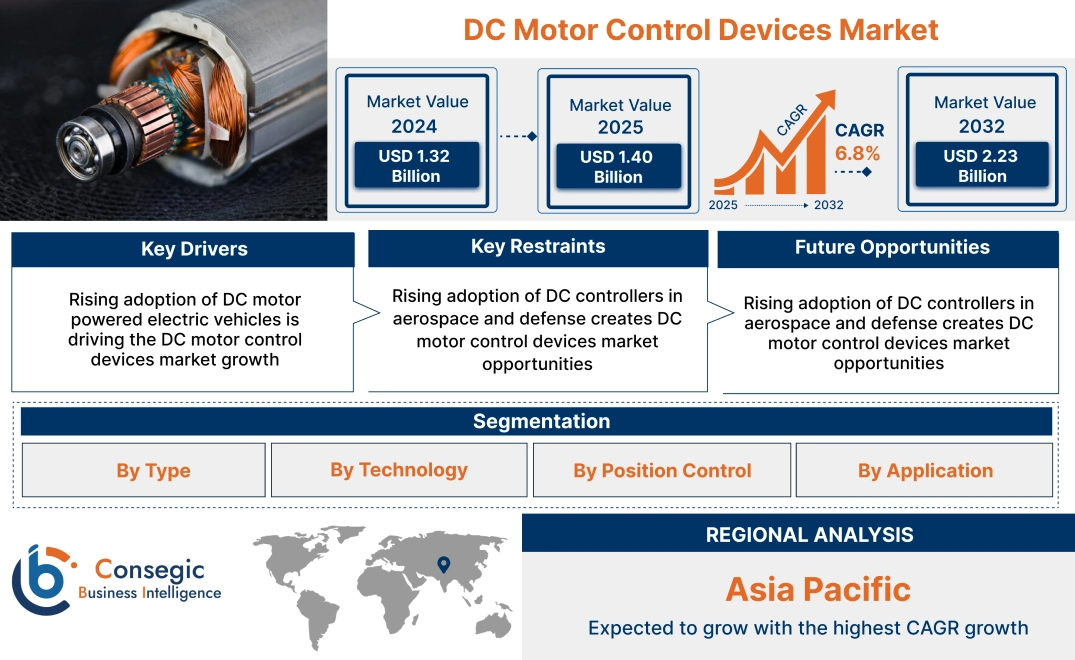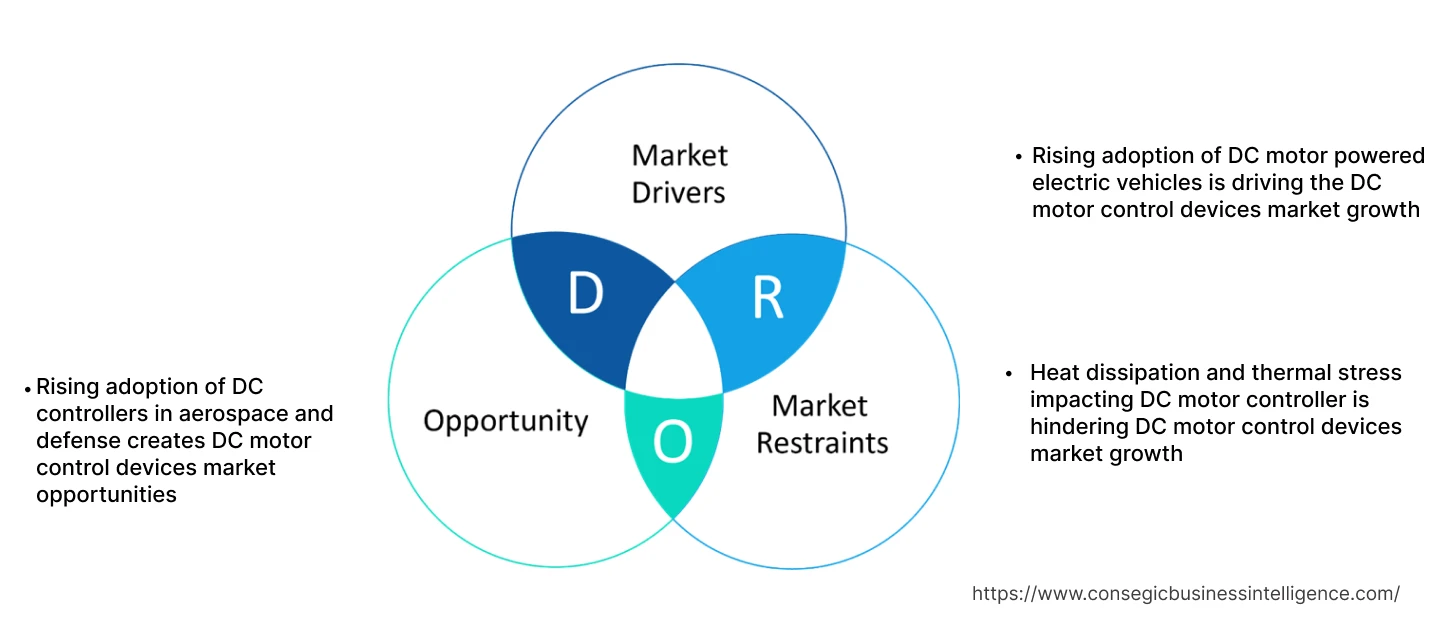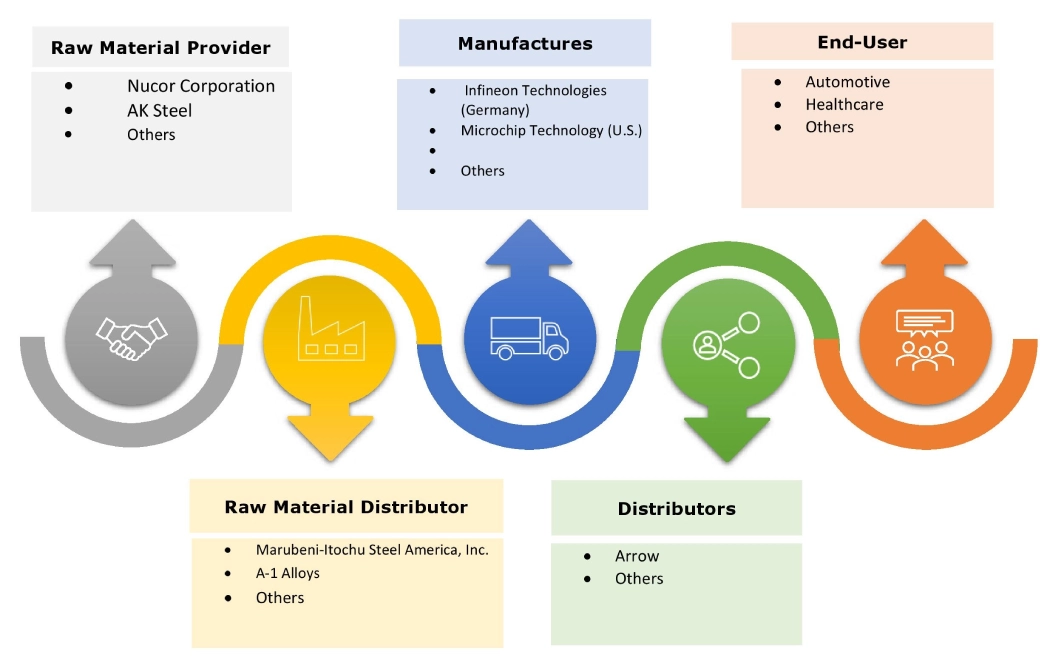- Summary
- Table Of Content
- Methodology
DC Motor Control Devices Market Size:
DC Motor Control Devices Market Size is estimated to reach over USD 2.23 Billion by 2032 from a value of USD 1.32 Billion in 2024 and is projected to grow by USD 1.40 Billion in 2025, growing at a CAGR of 6.8% from 2025 to 2032.
DC Motor Control Devices Market Scope & Overview:
A DC motor controller is a device utilized to manage the speed, direction, and other parameters of a DC motor. It employs techniques such as pulse width modulation (PWM) for speed regulation and H-Bridge configurations for directional control. These motors operate on direct currents, and the controller used on these motors is the DC motor controller. Moreover, DC motor controllers give speed control, ideal for various applications where accurate speed is important, such as robots and conveyors.
Key Drivers:
Rising adoption of DC motor powered electric vehicles is driving the DC motor control devices market growth
DC motor controllers are essential to the innovation and advancement of electric vehicles, providing precise control over motor performance, enabling regenerative breaking. Additionally, DC controllers operate on electricity enabling zero direct emission and maximizing efficiency, safety, and performance of EVs. Moreover, adoption of advanced technologies in motor controllers including vector control technology which ensures the motor can run smoothly and safely in different modes, even when the encoder is disconnected is also boosting the market growth.
- For instance, Veichi launched its Electric Vehicle motor controller for BLDC motors. This controller uses vector control technology to provide safe, stable, efficient, and quiet operation, along with easy installation. It ensures smooth and safe motor performance across various operating modes.
Thus, the enhancement in efficiency, performance, and longevity of electric vehicles by precisely managing motor operation, is driving the DC motor control devices market expansion.
Key Restraints:
Rising adoption of DC controllers in aerospace and defense creates DC motor control devices market opportunities
Thermal management is a critical aspect of DC motor controller design, as excessive heat generated during operation leads to component degradation, reduced efficiency, and even system failure. The primary sources of heat in a DC motor controller include resistive losses in power semiconductors, switching losses in PMW, and inefficiencies in current regulation. Excessive heat also causes thermal runaway, where rising temperatures create a self-reinforcing cycle that leads to component burnout. Due to continuous thermal stress circuit boards, solder joints weakening resulting in electrical failure, thereby impeding the global DC motor control devices market size.
Thus, excessive heat and thermal stress severely impact reliability, longevity of the components, further hindering DC motor control devices market size.
Future Opportunities :
Rising adoption of DC controllers in aerospace and defense creates DC motor control devices market opportunities
There is an increasing adoption of DC motor technologies in aerospace and defense sector for various critical aviation applications. Further, there are several DC motor technologies including brushless DC motors which offer various benefits including speed and position control in aircraft. Moreover, DC motors are implemented as a standalone unit or as a part of motion system in an aircraft for various aerospace functions. Additionally, DC motors are also used for various applications including controlling the flow of aircraft fuel for supporting the positioning of satellites.
- For instance, ARC power offers DC controller specifically suited for aerospace and space applications. It offers various features including a wide input range of 18V to 105V and essential protections for over-current, over-voltage, under-voltage, and over-temperature for ensuring efficient operation under extreme conditions.
Thus, the adoption of DC motor controller in aerospace and defense is expected to create future DC motor control devices market opportunities.
DC Motor Control Devices Market Segmental Analysis :
By Type:
Based on the type, the market is segmented into brushed and brushless.
Trends in the Type:
- A brushed DC motor widely used for enhancing the speed and torque of the motor by regulating the current and voltage injected into it.
- The increasing trend of brushless DC motor for offering quiet, smooth operation with less wear and tear and subsequently requiring less maintenance.
Brushed segment accounted for the largest revenue share in 2024
- Brushed DC motors operate at low speeds and are driven by a simple pulse width modulation (PWM) controller to vary the voltage supplied to the motor. This controls the speed in one direction and provides the torque needed for the motor to drive.
- Brushed DC motors are used in various applications, such as home appliances, consumer electronics, automotive, healthcare, and industrial applications.
- For instance, the STSPIN240 of STMicroelectronics is a dual brush DC motor driver integrating a low RDS (ON) power stage in a small QFN 3 x 3 mm package. The STSPIN240 offers a complete set of protection including overcurrent, over temperature and short-circuit protection.
- Thus, as per the DC motor control devices market analysis, the wide usage of brushed DC in industries is driving the DC motor control devices market demand.
Brushless is anticipated to register the fastest CAGR during the forecast period.
- BLDC motors utilize electronic controllers to manage the switching of current in the motor windings.
- BLDC motors offer high durability and low electric noise generation, due to the absence of brushes.
- For instance, Indus’s BLDC/DC motor controller to adjust the speed of the various DC motors by controlling armature supply. It is a hall sensor based BLDC motor controller, offers better efficiency, and better performance in both high and low speeds.
- Thus, the increasing adoption of BLDC motors due to their capability of producing low noises is driving the market DC motor control devices market demand
By Technology:
Based on technology, the DC Motor Control Devices market is segmented into analog controller, digital controller, pulse width modulation, and H-Bridge controller.
Trends in Technology:
- Increasing trend of analog controller for speed regulation of a DC motor.
- The PWM is widely used to vary the speed of the motor by controlling the motor terminal voltage.
PWM accounted for the largest revenue share of 64.4% in the year 2024
- Pulse Width Modulation (PWM) uses digital signals to control power applications and converts it back to analog with a minimum of hardware.
- PWM is used to increase the efficiency of the system, it is also effective at controlling motor speeds at low RPM than linear methods.
- PWM simulates an analog voltage output by repeating pulses for varying lengths of time.
- Thus, as per the DC motor control devices market analysis, the capability of PWM to control motor speed at low rpm is driving the DC motor control devices market growth.
H-Bridge controller is expected to witness the fastest CAGR during the forecast period.
- H-bridge drivers are constructed by combining a controller, output drivers and protection circuits into a single package.
- Additionally, the Full-Bridge (H-Bridge) has the ability to change the rotation direction of the motor, without manually reversing the supply wires.
- Moreover, the main advantages of using an H-Bridge driver is its high efficiency, rotation direction change, and breaking the motor.
- For instance, Toshiba has launched an H-bridge motor driver, “TC78H660FNG,” for brushed DC motors and stepping motors for applications that include mobile devices and home appliances.
- Thus, as per the analysis, the rising adoption of H-bridge motor driver in consumer electronics is driving the DC motor control devices market trends.
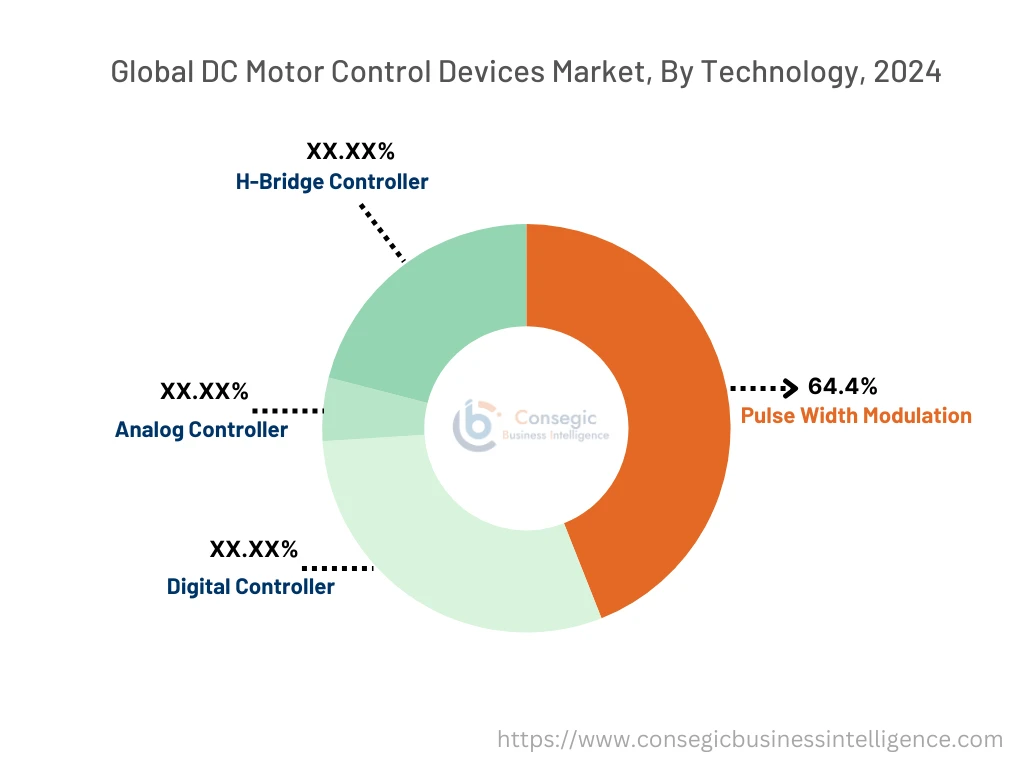
By Position Control:
Based on the position control, the DC Motor Control Devices market is segmented into close loop and open loop.
Trends in Position Control:
- A Closed Loop control system increases the motor voltage if it is running slower than desired.
- Open loop control system is ideal for manufacturing processes that do not require output changes.
Close loop accounted for the largest revenue share in the year 2024 as well as the fastest CAGR during the forecast period
- Using a DC motor control & devices with closed-loop speed continuously regulates the DC motor’s speed.
- Additionally, closed-loop systems are designed to automatically achieve and maintain the desired output condition by comparing it with the actual condition
- Moreover, the primary objective of a closed-loop control system is to enhance the system's stability, accuracy, and overall performance.
- For instance, Kollmorgen, motion control systems company, introduced the closed-loop P80360 stepper drive, which is fully programmable, enabling servo-like versatility, precision and repeatability in a stepper drive.
- Thus, as per the analysis, the advanced capability of closed-loop control to enhance stability and accuracy is driving the DC motor control devices market growth.
By Application:
Based on the application, the DC Motor Control Devices market is segmented into industrial automation, robotics, healthcare, consumer electronics, energy & power automotive, and others.
Trends in Application:
- Robotic arms and manipulators are commonly used in manufacturing, assembly lines, and medical applications. DC motor controllers are integral to these systems, providing the necessary torque and speed control for the joints and actuators.
- DC motors are often applied to medical advancements, giving medical applications greater accuracy and professional control.
Consumer Electronics accounted for the largest revenue share in the year 2024
- Consumer electronics also benefit from smart ICs, ensuring precise control of the DC motors for focus, zoom, and rotation in camera lenses, optical drives, and CD/DVD players–enhancing the user experience.
- Additionally, in smart home appliances, such as robotic vacuum cleaners, DC motor provides necessary power for robust operation while maintaining a compact and lightweight design, enhancing user convenience.
- For instance, Toshiba Electronic Devices & Storage Corporation ("Toshiba") has launched two products of 600V small intelligent power device (IPD) for brushless direct current motors drive applications such as air conditioners, air cleaners, and pumps.
- Thus, as per the analysis, the increasing integration of dc motor controller in consumer electronics is driving the DC Motor Control Devices market expansion.
Industrial Automation segment is expected to register the fastest CAGR during the forecast period.
- DC motors controllers manage the speed and movement of conveyor belts, ensuring smooth and efficient material handling in manufacturing and packaging industries.
- Additionally, these controllers enable precise lifting and lowering of heavy loads, improving safety and efficiency in construction and warehousing.
- For instance, in April 2021, Johnson Electric launched ECI-048 brushless DC motor platform, a platform for sensor less control which is used for various different industrial applications including blower, hedge trimmer, and others.
- Thus, the rising adoption dc motor controller in industries is driving the DC motor control devices market expansion.
Regional Analysis:
The global market has been classified by region into North America, Europe, Asia-Pacific, MEA, and Latin America.
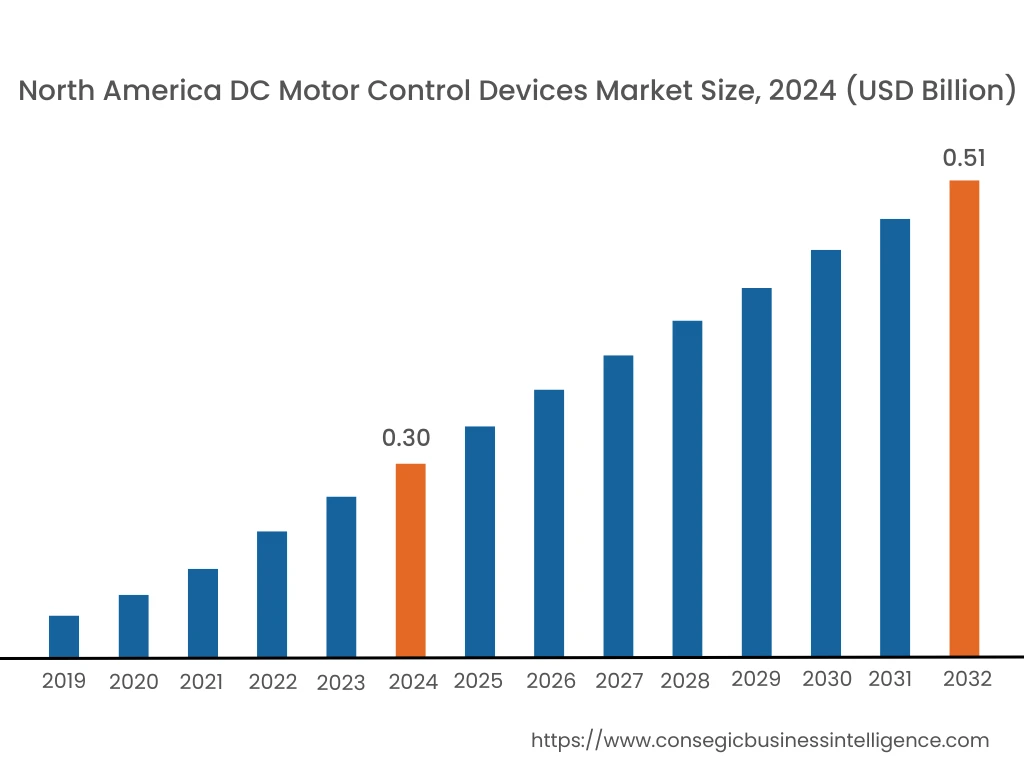
North America region was valued at USD 0.30 Billion in 2024. Moreover, it is projected to grow by USD 0.32 Billion in 2025 and reach over USD 0.51 Billion by 2032. Out of these, U.S. accounted for the largest share of 74.3% in 2024.
North America DC motor control devices market share is witnessing significant growth due to the presence of leading companies specializing in innovative product development, advanced technologies, and efficient supply chains. Additionally, these manufacturers focus on meeting regional demand through strategic production to various industries. Further, major players in this market prioritize sustainability, quality standards, and customer-centric solutions, which in turn, is spurring the DC motor control devices market expansion.
- For instance, TTM Technologies Inc. holds MIL-PRF-38534 certification and qualification for both Class H (military) and Class K (space) microelectronics. They provide a diverse selection of motor controllers suitable for various servo and speed control needs.
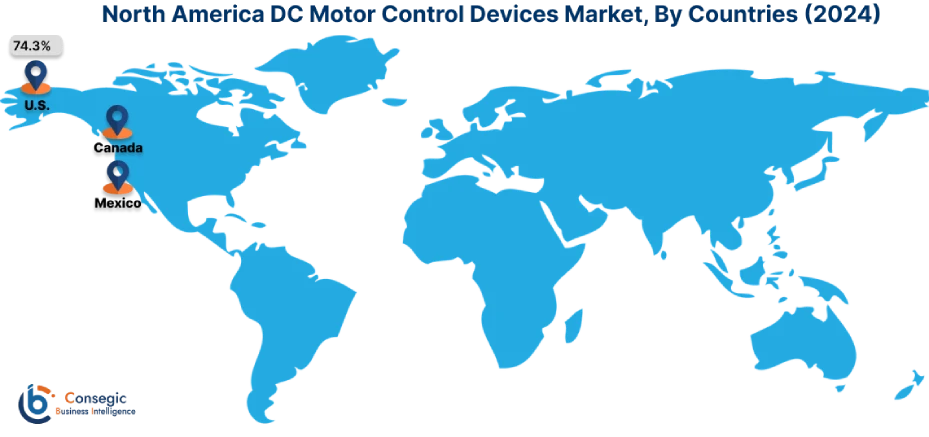
Asia Pacific region was valued at USD 0.57 Billion in 2024. Moreover, it is projected to grow by USD 0.60 Billion in 2025 and reach over USD 0.98 Billion by 2032.
Asia-Pacific DC motor control devices market advancement is driven by the emerging economies of Asia-Pacific region, including China, India, and Southeast Asia. The region is also a global center for electric vehicle production and adoption, significantly propelling the need for DC motor controllers. Technical advancements and strong investment in research and development further enhance the market, enabling the creation of advanced and cost-effective controllers. Moreover, government policies promoting energy efficiency and EVs, along with growing automation across industries contribute to market expansion.
- For instance, in March 2021, the Thai government passed the country's latest EV policy, with the aim of making all vehicles produced in Thailand electric by 2035.
As per the analysis, the major industries of Europe, such as automotive, consumer electronics, industrial automation, and aerospace, are adapting BLDC motors due to their specific advantages in these applications. The region is witnessing growth in the DC motor controller due to stringent energy efficiency regulations, which drive the adoption of advanced motor control technologies to reduce energy consumption and emissions. The Latin America region is experiencing growth in DC motor controller market due to increasing industrialization and the adoption of automation technologies across various sectors including manufacturing, agriculture, and mining. The MEA region is seeing growth in DC motor controller market due to focus on diversifying energy sources particularly in solar and wind power, which drives the demand of DC motor controller.
Top Key Players and Market Share Insights:
The market is highly competitive with major players providing DC motor control devices to the national and international markets. Key players are adopting several strategies in research and development (R&D), product innovation, and end-user launches to hold a strong position in the market. Key players in the DC motor control devices industry include:
- NXP Semiconductors (Netherlands)
- Analog Devices (U.S.)
- Infineon Technologies (Germany)
- Microchip Technology (U.S.)
- Rockwell Automatic, Inc. (U.S.)
- General Electric (U.S.)
- KB Electronics, Inc. (U.S.)
- STMicroelectronics (Switzerland)
- Texas Instruments (U.S.)
- Eaton Corporation Plc (Ireland)
- OMRON Corporation (Japan)
Recent Industry Developments :
Partnerships & Collaborations:
- In 2024, ON Semiconductor collaborated with Theta Power Systems International. This collaboration enabled customers to capitalise on motor control techniques along with high performance semiconductor solutions targeting applications migrating to brushless DC (BLDC) motors.
DC Motor Control Devices Market Report Insights :
| Report Attributes | Report Details |
| Study Timeline | 2019-2032 |
| Markett Size in 2032 | USD 2.23 Billion |
| CAGR (2025-2032) | 6.8% |
| By Type |
|
| By Technology |
|
| By Position Control |
|
| By Application |
|
| By Region |
|
| Key Players |
|
| North America | U.S. Canada Mexico |
| Europe | U.K. Germany France Spain Italy Russia Benelux Rest of Europe |
| APAC | China South Korea Japan India Australia ASEAN Rest of Asia-Pacific |
| Middle East and Africa | GCC Turkey South Africa Rest of MEA |
| LATAM | Brazil Argentina Chile Rest of LATAM |
| Report Coverage |
|
Key Questions Answered in the Report
How big is the DC Motor Control Devices Market? +
DC motor control devices market size is estimated to reach over USD 2.23 Billion by 2032 from a value of USD 1.32 Billion in 2024 and is projected to grow by USD 1.40 Billion in 2025, growing at a CAGR of 6.8% from 2025 to 2032.
What specific segmentation details are covered in the DC Motor Control Devices report? +
The DC motor control devices report includes specific segmentation details for type, technology, position control, application and regions.
Which is the fastest segment anticipated to impact the market growth? +
In the DC motor control devices market, the brushless segment is the fastest-growing segment during the forecast period.
Who are the major players in the DC Motor Control Devices Market? +
The key participants in the DC Motor Control Devices Market are, NXP Semiconductors (Netherlands), Analog Devices (U.S.), Infineon Technologies (Germany), Microchip Technology (U.S.), General Electric (U.S.), KB Electronics, Inc. (U.S.), STMicroelectronics (Switzerland), Texas Instruments (U.S.), Eaton Corporation Plc (Ireland), OMRON Corporation (Japan), Rockwell Automatic, Inc. (U.S.), and others.
